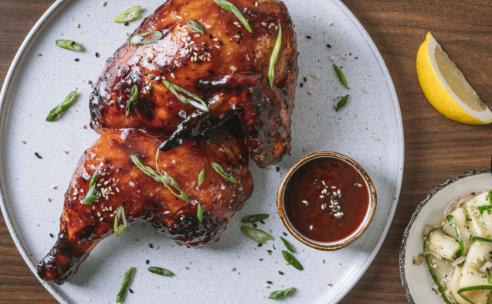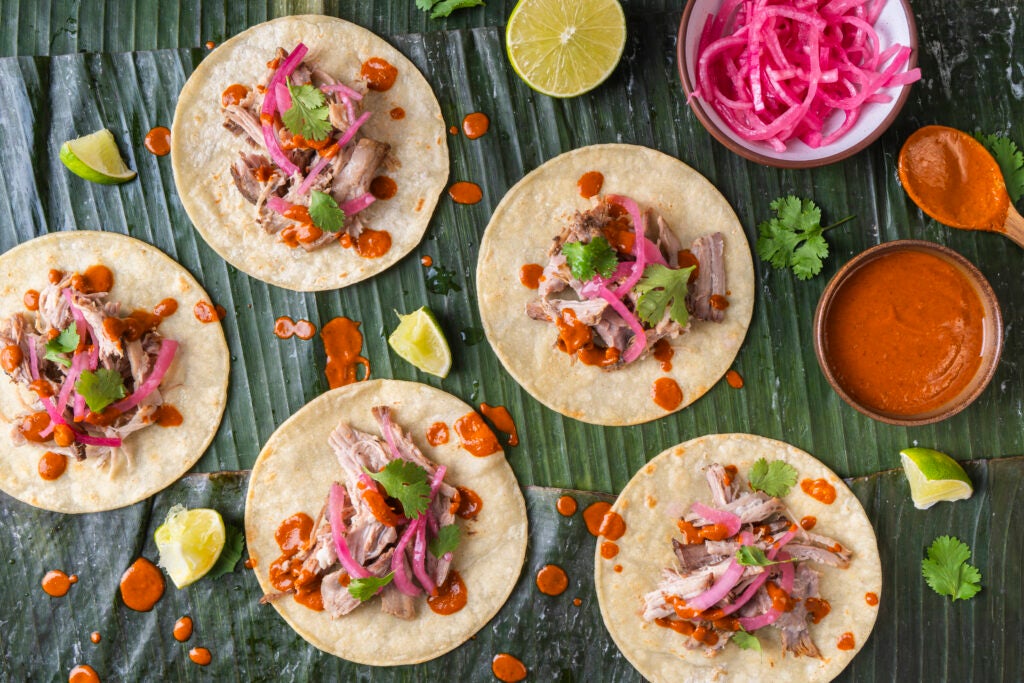Who’s ready for a culinary cross-cultural journey that blends global flavors and smoky barbecue?
Get ready to take your customers on a trip that combines exotic-tasting seasonings with the slow-cooked tenderness of BBQ. It’s easier than you may think to incorporate into any kitchen, and it comes at a time when consumers are hungry for menu differentiation.
Global flavors and BBQ have been around ever since cave dwellers first wrapped wet leaves around meat and roasted it over a low fire. Today, Mediterranean, Asian and South American spices are soaring in popularity. Meanwhile, BBQ is becoming a menu favorite at places that don’t necessarily have a neon pig dancing on their sign.
“Barbecue has been so hot, using time and technique to develop something special,” said Kurt Kwiatkowski, Gordon Food Service Corporate Executive Chef. “So, if I make really, really great barbecue chicken, I can throw some Korean flavor onto it and make Korean glazed chicken.”
Global BBQ Finds a Fit in Any Kitchen
The phrases “slow-cooked” and “time and technique” shouldn’t scare operators looking for quick and easy solutions. BBQ takes a while to cook, but much of that time is passive. It takes minimal labor to add a rub to meats or seafood and let them sit for a day in the refrigerator.
Even the hours cooking in the smoker are largely unattended, Kwiatkowski noted. “That’s the beauty of it. You just need someone to watch the grill. While it’s cooking, you can redistribute staff to do other things.”
You don’t need to be a pitmaster to amp up the menu. For operators without smoker capabilities, there are speed-scratch options to add BBQ to the menu. Consider smoked pork bellies, pre-cooked pulled pork, ready-to-heat beef barbacoa, and even pre-cooked marinated chicken.
“If you want to be a differentiator, just start with one of those options,” Kwiatkowski said. “Tweak it a little bit with some seasonings or serve with a Korean gochujang, chimichurri or other sauce on the side.”
A Global BBQ Sampler
A global BBQ limited-time offer can help operators gauge customer interest in a dish. There are a number of kitchen-tested recipes available from Gordon Food Service. Chef Kurt highlights recipes featuring three core proteins – fish, chicken and beef. All are right at home on menus from sandwich shops to fine dining.

Smoked Fish Taquitos. Raise the bar on common fish and shrimp tacos. This dish starts with smoked whitefish, shredded Chihuahua cheese, oregano and ancho Chile seasoning. Combine them as a filling and roll them up in a tortilla shell that gets deep-fried and topped for service with a smooth Veracruz sauce dotted with capers.
“You get this kiss of mesquite from the fish – smoked but not overpowering,” Kwiatkowski said. “There’s a depth of flavor and smoke that carries the dish. It’s something you don’t see very often, and it works for barbecue spots that want to change things up, casual restaurants, gastro pubs, or even fine dining.”

Sake Brined Gochujang Glazed Chicken. Two countries on the Pacific Rim combine to create a flavorful chicken dish inspired by barbecued sticky ribs. Chicken halves are soaked in a brine tinged with Japanese rice wine, then slow-smoked. During the smoking process, the chicken is basted with a Korean gochujang magi sauce.
“This is a very different take on poultry brine,” Kwiatkowski said. “The Korean barbecue sauce glaze combined with the flavor of smoked or grilled chicken adds depth of flavor.”

Nihari Beef Belly Sando. Economical beef belly gets the royal treatment with Indian spices – cardamom, cloves, star anise, nutmeg, ginger, cinnamon, turmeric and more. It gets layered on a Dutch Crunch roll and topped with colorful giardiniera and served with a side of au jus.
“This uses a different cut of beef that acts like the point end of a brisket without much trimming. Add in barbecue technique of cooking it low and slow and the aromatic flavors of the Northern India nihari seasoning bring this sandwich to life,” the chef said.
Global BBQ Opportunities Abound
Indian food and barbecue are a rare combo, but they demonstrate how easy it is to cast aside many of the rules when it comes to flavor mashups.
The gochujang glaze would work perfectly on a rib dish. North African spices (think coriander, cumin, allspice, ginger) come to life in a ras al hanout leg of lamb. Old-school Mayan flavors like sour citrus, chile paste and cinnamon can be used to create smoked cochinita pibil.
There also are global BBQ opportunities for vegetables and fruits. Oak-grilled zucchini adds a touch of smoke to the mild squash, and a Southeast Asian cashew sambal sauce and an Italian walnut bagna càuda to bring spicy, savory, smoky richness to the table.
Smoked eggplant with a miso glaze takes baba ganoush to a new level. Slow-cooked Japanese eggplant with a miso glaze presents at the table as a smoky appetizer perfect for scooping or spreading on toast points. “It’s a big umami bomb,” Kwiatkowski said.

For a finishing touch, try a dessert featuring grilled pineapple. The deep, caramelized char marks on the pineapple create a smoky sweetness that pairs well with coconut sticky rice.
“Barbecue at its core is taking time to develop flavor and tenderness in whatever you are cooking and enveloping that smoke or charcoal element,” Kwiatkowski said. “Because we are seeing more world flavors, we are now seeing a much broader spectrum of ingredients being used.”











